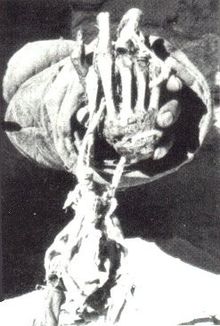
The complete BBC program on “The Yeti Finger” may be found here.

When this Pangboche finger is placed in the context of the history of what was previously said about it, other such relics and their discussion by Westerners, it is clear caution should have been a hallmark of the investigation from the beginning.
But then again a verdict of “human,” perhaps an “Asian,” must be further explored. What was meant by a finding of “human”?
As already mentioned, the story is in the details, and we need a full accounting of those.
This history of the Pangboche hand has been unfolding in the last few days. But for students of the Yeti, we have known for a long time this was thought to be “human,” whatever that means.

One of the Slick-Johnson Snowman Expedition photos from 1958 of the Pangboche Yeti Hand.
After digging and rediscovering material lost for decades, I wrote a biography of the famed San Antonio cryptozoology expedition sponsor, thirty years after his expeditions. The Pangboche hand was an important piece of the unique nature of Slick’s work.
 A Japanese expedition also photographed the Pangboche Yeti Hand.
A Japanese expedition also photographed the Pangboche Yeti Hand.
In Tom Slick and the Search for the Yeti (Boston: Faber and Faber, 1989; page 79), I penned this: “Slick’s expedition also revealed for the first time that the lamas possessed ‘Yeti hands.’ Slick proved that a hand, wrist, and forearm at Makalu were actually those of a snow leopard. But the Slick-Johnson Snowman Expedition did obtain the very first photographs of a very old and mummified Yeti hand found at Pangboche. This discovery gave Slick’s associates much to ponder, to analyze, and to seek well into 1959.”

The “Malaku Yeti” hand and arm” were discovered by the Slick-Johnson Snowman Expedition of 1958, but quickly found to belong to a snow leopard.
Dr. W. C. Osman Hill, via Peter Byrne to Jimmy and Gloria Stewart to F. Kirk Johnson, Jr. to Hill (see p. 91 of Coleman, 1989), received the Pangboche Yeti Hand (“a grisly trophy”) on February 20, 1959.
On February 26, 1959, in a document I personally examined, from Hill to Slick, Hill wrote: “Pangboche Hand: This proves to be from examination of the thumb and phalanx to be human.”
But then great discussions occurred regarding the flatness of the metacarpals.
Anthropologist George Agogino pointed the “very flat metacarpals” as his reasoning for feeling the hand had “very primitive characteristics,” as quoted by Gardner Soule in 1967. Similar verdicts started coming in from other Slick consultants regarding the massive nature of the metacarpals (see page 91 of my book for the specific quotes).
In a letter to Tom Slick on July 5, 1959, Hill demonstrated he had changed his mind, slightly about the Pangboche hand. He no longer felt it was fully human. In 1960, Hill told Ivan T. Sanderson that the hand might have come from a Neandertaler. We have a record of these thoughts in Sanderson’s Abominable Snowmen: Legend Come to Life, and in a scientific paper on the matter.
As my French cryptozoology associate Michel Raynal has emailed: “The first photographs of the hand of the temple of Pangboche were published in 1958. Since 1959, the primatologist William C. Osman Hill, who had studied the returned fragment from Nepal, concluded the artifact was a human hand, perhaps with affinities to Néandertals. That was still confirmed three years later in an article published in the Genus review: DEMENTIEV, G.P., Mr. F. NESTURKH, B.F. PORSHNEV 1962 ‘The mano di a ignoto primate superiore.’ Genus. Therefore, that 50 years later, a DNA test shows the artifact is a human hand, there is nothing new is such a revelation. The only question which is important is to know if affinities to Néandertals are confirmed or not [and] today with the genome of several Néanderthaliens, therefore if sequencing DNA of the finger in question is one day published, it will be interesting to make the comparison.”
Is the finger from a Neandertal or a Tibetan monk? What new chapter has this unpublished BBC analysis of the Yeti Hand added to this mystery? What comparative analyses might remain to be made?
Follow CryptoZooNews
Not Found
The resource could not be found.